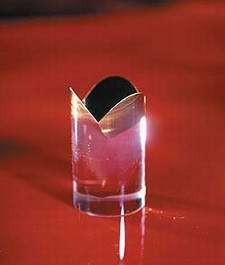Aussie ingenuity helps NASA search for new planets

CSIRO's success with a new manufacturing technique for a piece of astrometry equipment is likely to help American scientists detect planets in our galaxy and beyond.
CSIRO Industrial Physics has mastered the manufacturing technique for the retro-reflector, called a cube corner, at its Lindfield laboratories. On Thursday morning, Dr Ben Platt from NASA's Jet Propulsion Laboratory in Pasadena, California, is collecting a cube corner, which is essential to the hunt for planets around nearby stars.
Astronomers need telescopes that can make precise measurements down to thousandth of a millimetre and the cube corner enables a level of accuracy not previously available.
Because planets have a gravitational "tug" on the sun which they orbit, astronomers look for planets by narrowing down their search to "wobbly" stars.
To spot this stellar shimmy, astronomers have to know exactly where a star is in relation to other stars. NASA's SIM PlanetQuest spacecraft, launching in 2011, will pin-point stars using telescopes mounted on each end of a 10 metre long scaffold on the spacecraft. But a star dozens of light years away won't look like it has much wobble, so these measurements have to be very precise. To do this, astronomers need to measure the distance between the telescopes continuously as this separation changes by microscopic amounts (less than the width of an atom) due to the manoeuvring of the spacecraft.
Lasers are used to measure the distance between the telescopes – and that's where cube corners come in. Cube corners made by the team at CIP are accurate to within one tenthousandth of a degree or within five thousandths of a millimetre.
Cube corners are made by bringing together ultra-smooth, ultra-clean pieces of Zerodur, a glass-like substance similar to ceramic hot plates. Zerodur knits together molecule by molecule in a process called optical contacting.
"No other organization has ever fabricated a cube corner to these accuracies." says Dr Bob Oreb, leader of the fabrication team. "This component has been declared a JPL Critical Item because of its importance to JPL in completing a key NASA milestone. Because of its critical status, it must be hand carried from CSIRO to JPL in a specially fabricated carrying case."
Dr Gerry Haddad, Chief of CSIRO Industrial Physics, says "The team's achievement significantly enhances CSIRO's, and Australia's, international reputation as a source of leading-edge technological developments. It shows the world that we can have an impact on frontier space exploration"
Source: CSIRO

















